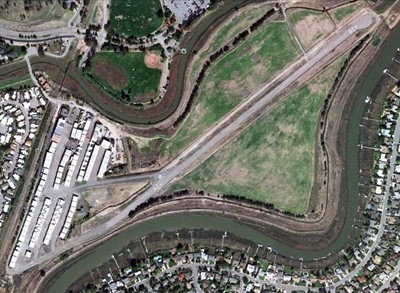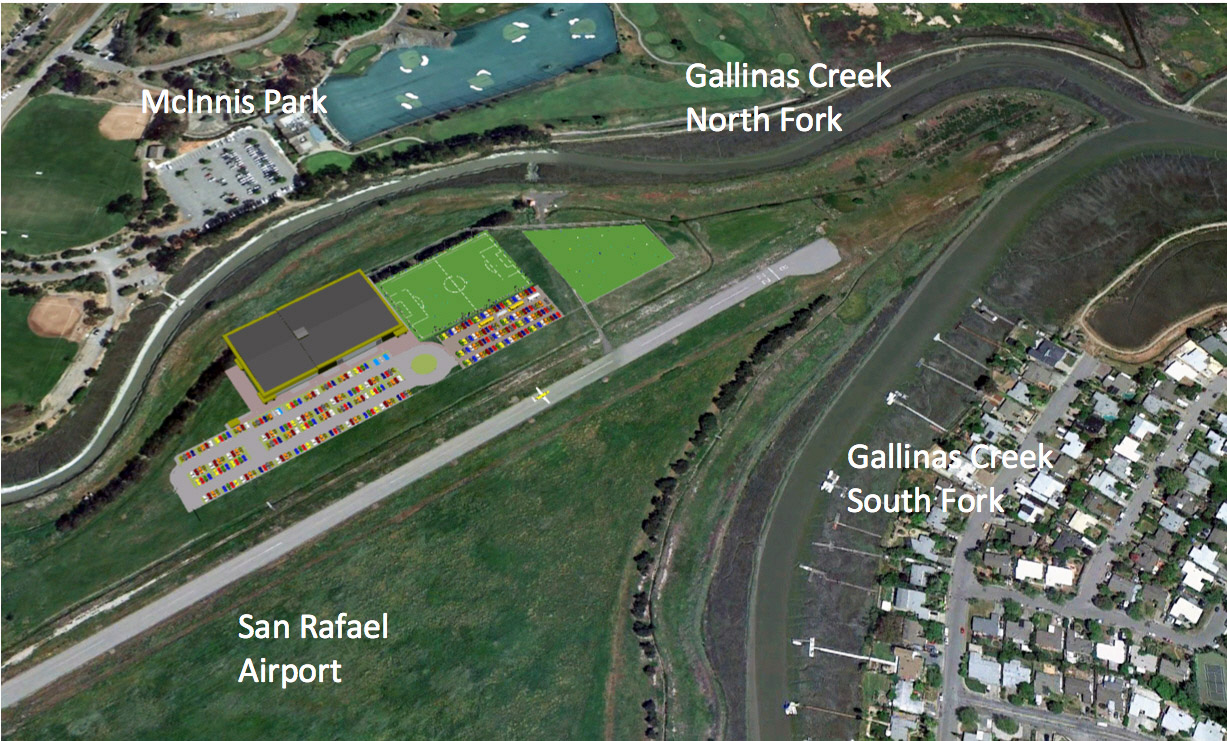 San Rafael Airport MarinSoccer Complex Hearing Postponed Following Allegation of Mayor’s Conflict of Interest – Monday’s public hearing for the San Rafael Airport’s proposed soccer complex was rescheduled so Mayor Gary Phillips, who has a lease with the airport, could obtain written approval from a state agency that will allow him to participate in the decision.
San Rafael Airport MarinSoccer Complex Hearing Postponed Following Allegation of Mayor’s Conflict of Interest – Monday’s public hearing for the San Rafael Airport’s proposed soccer complex was rescheduled so Mayor Gary Phillips, who has a lease with the airport, could obtain written approval from a state agency that will allow him to participate in the decision.
The planned public hearing on the San Rafael Airport‘s proposed soccer facility has been postponed following an allegation that Mayor Gary Phillips should recuse himself from the meeting due to a conflict of interest.
 Phillips, who has a lease with the airport for a private hangar, requested written direction from the Fair Political Practices Commission, a state agency that strives to enforce objectivity in policy decisions, to confirm that he may lawfully participate in the decision.
Phillips, who has a lease with the airport for a private hangar, requested written direction from the Fair Political Practices Commission, a state agency that strives to enforce objectivity in policy decisions, to confirm that he may lawfully participate in the decision.
“The city has been processing the soccer facility application for more than five years and it is obviously a significant local land use decision,” City Attorney Rob Epstein said in a statement. “Under the circumstances, I think it is appropriate for the mayor to seek a pre-decision ruling, and for the city to delay the hearing on the matter until that ruling is obtained.”
According to the FPPC, a public official must recuse himself from any decision where he has a financial interest in the outcome. San Rafael resident Barry Taranto first brought up the potential conflict of interest during the open public comment during a City Council meeting last month.
The decision to postpone the hearing was made by Assistant City Manager Jim Schutz and Epstein, who reviewed the allegations of conflict and determined that there is no disqualifying conflict.
“This opinion is shared by the mayor’s private counsel, Vigo G. “Chip” Nielsen, a well-known expert on political law,” Shutz said in a release.
Despite this opinion, Nielsen notified city staff that he intends to request that the FPPC provide a written ruling to confirm that Phillips may participate in the decision.
The planned recreational building, which was first proposed in 2004, was approved by the Planning Commission in early June. The complex will house indoor soccer fields and courts with spectator seating, offices, food and beverage service and meetings rooms. There will also be two outdoor soccer fields with parking and exterior lighting.
The City Council meeting was scheduled for Aug. 6. City officials did not give a new date for the meeting.
CalPilots Editor’s Note: Please note the location of this proposed facility on the lower right side picture. This is not a safe location to build this facility and the City Council should know that. Further, the Caltrans Division of Aeronautics (DoA) sent a letter advising against the location based upon safety concerns (see attached at the bottom).
CalPilots Response
November 16, 2012
To: The San Rafael City Council
Subject: Airport Sports Development
The California Pilots Association (CALPILOTS) mission is to promote and preserve the State’s airports. We actively promote safety at all levels of aviation activity including safety related to land use planning.
We are stunned that the application for the San Rafael Airport Recreational Facility, catering to scores of children in open playing fields or in a building unreinforced against major impact, located extremely close (160 feet – 350 feet) to the San Rafael Airport runway, is being given serious consideration by the City of San Rafael.
The letter sent to Mr. Kraig Tamborini of the Planning Division from Mr. Ron Bolyard of the California Division of Aeronautics (March 9, 2012) strongly recommended prohibiting this project on the San Rafael Airport, in the proposed location. We fully support this prohibition based on the California Airport Land Use Planning Handbook (CALUPH) recognizing the number of incidents which occur in zones 2 and 5 (for all airports into which zones this development falls) and the duty of a governing body to give extra protection to children and for the following reasons:
1. Examination of the plans for the project shows the location only barely meets and sometimes even violates the very minimum of standards considered safe for a project which would normally not include this vulnerable group of our population.
2. Historically, the record of many of the “incidents” located in safety zones 2 and 5 (CALUPH), would have been of greater magnitude had the hazards of the proposed structure, parking lot, vehicles and light standards been located similar to those proposed by the applicant for the San Rafael Airport Recreational Facility. These “incidents” were not included in the calculations used in the California Airport Landing Use Planning Handbook. If they had been, the 27% of all aircraft “accidents”, a considerable percentage in itself, which do occur in these sensitive zones, would have been much higher!
3. The present San Rafael Airport runway is restricted by urban areas, rising high terrain, and a narrow short runway. Operations are compromised by downwind departures (encouraged by the operator and the city), the airport’s lack of some safety features for the runway, a taxiway, a clear area at the north-east end of the runway, etc. All these factors increase the value of the safety factor of open space provided by the area on which this project would sit. San Rafael Airport Recreational Facility
4. The proposed project would increase the risk for an accident because of wind disturbance from the proposed large structure, convective currents from the parking lot, glare from windshields of vehicles, the obstructions of the building and the light standards, headlights from moving vehicles and the outdoor lighting increasing confusion at night, even the multiple vehicles and people moving in extremely close proximity to the runway necessarily lead to distraction and greater challenges to pilots, increasing the chance for error in judgment and control.
5. The FAA and NTSB records, easily accessible by your planners, list scores of tragic aircraft accidents which have occurred directly in zones 2 and 5 of airports similar to the San Rafael Airport. To place children in these zones of proven risk, as proposed by this project, is unthinkable.
Despite the seductive appeal of the merits of the project, we encourage you to reject it as a violation of your duty to protect children from this documented risk.
 Respectfully submitted,
Respectfully submitted,
Carol Ford
Vice-President – California Pilots Association
